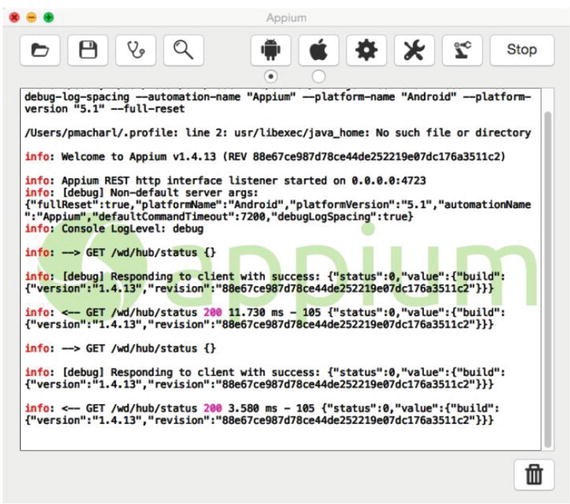

- #Appium tutorial ebooks full#
- #Appium tutorial ebooks android#
- #Appium tutorial ebooks code#
- #Appium tutorial ebooks download#
contains ‘Notifi’ would probably also work: 'Notifications tab')]Īlso, you could for example search for any UIAStaticText element that does not have a name-value that contains at least ‘_subtitle’, as illustrated in the example below: '_subtitle'))]Īnd finally, any that has content-description (content-desc) of ‘Back’. The “contains” call is great because we can use only a part of the value. The C# example isn’t really different from Java but the syntax is naturally according to C#: // The Same example as the first on Java, but with c# Testdroid Cloud']")) Additional Examplesįor example, any iOS element type of UIAElement, that contains at least ‘Notifications tab’ in a value. * Any with resource-id value ':id/editText1' Button index 1, with parent LinearLayout index 2, with parent LinearLayout index 1, with parent ScrollView index 1. RadioButton) and the XPath call with return any given parameter defined inside the function call: /* Any with text value 'Use Testdroid Cloud' Testdroid Cloud']"))

#Appium tutorial ebooks android#
The indexes can be given the same way for native apps as those are given to websites, for example: (All UIAButtons, with parent UIAWindow index 1, with parent UIAApplication index 1) "//UIAApplication/UIAWindow/UIAButton") Java Example with Native Android Appįor example, certain UI elements can be located using the UI element definition (e.g. The visual inspection should look like this (Chrome Developer Tools -> Inspect): Ruby with Native iOS ApplicationĪs discussed in the two prior blogs about identifying and locating the UI elements, the XPath can be also identified using the uiautomatorviewer or Appium inspector. The second one (menu-why-testdroid) contains a list (menu) and sub-items can be found if index definition is used.
#Appium tutorial ebooks code#
We start with a basic example: to find the “a” element, with parent “li” of index 1, with parent “ul” of any index, with any type of parent with id “menu”, the example goes as follows: following examples allow you to go in sub-divisions of product ‘ID’: following HTML code can be found using the web browser’s Inspect tool: 'navbar-toggle 'navbar-brand')]")

Here are a few basic examples with appropriate driver->find_element calls. Regardless of what programming language you are using, the XPath parameter is built up the same way. XPath Tutorial and Few Appium Examples for Different Languages You can even leave the element type out of the criteria if you can’t be sure what type of element it will be.
#Appium tutorial ebooks full#
You can either make a full XPath query with specific indexes for each parent/child or make it more generic and use other search criteria, such as attribute values of the element. There isn’t necessarily “the right way” to do this, but in general, good advice is to keep it simple and as straightforward as possible. Going into how XPath parameters are formulated, some of the XPath queries can be made in many different ways.
#Appium tutorial ebooks download#
Download our free Appium beginner’s tutorial and check if you have a proper setup to successfully and efficiently use XPath Locators. The XPath is originally designed to allow the navigation of XML content with the purpose of locating individual UI elements, attributes and some other things in an XML content. Using the name, ID or link information (text) for your Appium tests is just fine, but when use cases are becoming more complex and there is more logic in your websites, you might want to consider using XPath. This is the eighteenth blog in our Things You Should Know About Appium – and now, let’s take a look at those different XPath tricks you might find useful. And in fact, there are lots of different XPath methods you can use, by name, ID, link texts, partial link text, tags, class names and some others. Appium – based on Selenium foundation – provides excellent methods to locate elements by using an XPath function. As we’ve been discussing here at Appium Weekly blog, there are various different ways and tricks to locate elements on a web page.


 0 kommentar(er)
0 kommentar(er)
